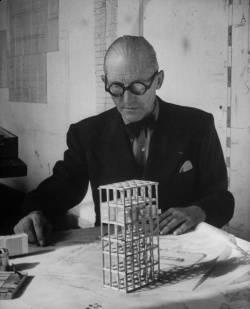Le Corbusier
Charles-Édouard Jeanneret-Gris, better known as Le Corbusier (1887 – 1965), was an architect, designer, painter, urban planner and writer.
Contents
Life and work
Born in Switzerland and becamed a French citizen (1930), Le Corbusier is one of the pioneers of what is now called modern architecture. Young Jeanneret was attracted to the visual arts and studied watch engraving at the La-Chaux-de-Fonds Art School, under Charles L’Eplattenier (1900). In 1904, he enters the Advanced Decorative Arts Course (based at the Art School) directed by Charles L’Eplattenier, who interests Le Corbusier in architecture. A member of the Board of the Art School, Louis Fallet commissioned to young architect to design a villa (Villa Fallet), which he builds in collaboration with the architect René Chapallaz . The villa is a house located in La Chaux-de-Fonds (Switzerland) designed by young Le Corbusier. It was his first commission as an architect at the age of 17. It was completed in 1905. Now it is recognised as a building of cultural significance in Switzerland. In september 1907, Le Corbusier takes a trip to Italy for two and a half month (Milan, Florence etc.), and on his back home in Vienna he works on the plans for the Stolzer and Jacquemet villas (La Chaux-de-Fonds). In Paris, he works for Auguste and Gustave Perret as draughtsman, half-time (1908). In autumn 1909 he returns to La Chaux-de-Fonds to supervise construction of the Stotzer and Jacquemet villas.
Works
- Selection
- Villa Fallet, Switzerland, 1905
- Villa Stotzer, Switzerland, 1907
- Villa La Roche, Paris, France, 1923
- Villas at Weissenhof Estate, Stuttgart, Germany, 1927
- Tsentrosoyuz, Moscow, Russia, 1928
- Maison Errazuriz, Chile, 1930
- Curutchet House, La Plata, Argentina, 1949
- United Nations headquarters, New York City, 1952
- Mill Owners' Association Building, Ahmedabad, India, 1951
- National Museum of Western Art, Tokyo, Japan, 1957
- Philips Pavilion at the World Expositon Brussels, Belgium, 1958
- Center for Electronic Calculus, Olivetti, Milan, Italy, 1961
- Church of Saint-Pierre, Firminy, Firminy, France, designed in 1960, built posthumously and completed under José Oubrerie's guidance, 2006
Literature
- By Le Corbusier
- Étude sur le mouvement d’art décoratif en Allemagne (Study of the decorative art movement in Germany), 1912
- Vers une architecture, 1923
- Toward an Architecture, 1st ed., 1931, 1986
- El viaje de Oriente, 1984, 1993 (Spanish trans.) [1]
- Analisis de la Forma, 1984 (Spanish trans.) [2]
- (Willy Boesiger, Oscar Stonorov, Max Bill editors) Le Corbusier - Oeuvre complete, vol. 1 (1910-1929), Vol. 2 (1929-1934), Vol. 3 (1934-1938), Vol. 4 (1938-1946), Vol. 5 (1946-1952), Vol. 6 (1952-1957), Vol. 7 (1957-1965), Vol. 8 (1965-1969) (French, English and German Edition), 1990-
- About Le Corbusier
- Jacques Lucan, Le Corbusier - Une Encyclopedie, 1987 (in French)
- Curtis, William J.R., Le Corbusier: Ideas and Forms, Phaidon, 1994
- Frampton, Kenneth, Le Corbusier, London, Thames and Hudson, 2001
- Eliel, Carol S., L'Esprit Nouveau: Purism in Paris, 1918 - 1925. New York: Harry N. Abrams, 2002
